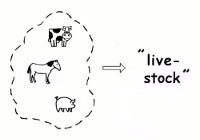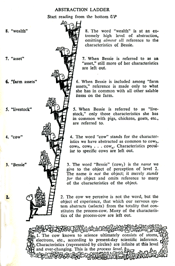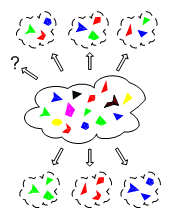The ladder of abstractions
 The
widely held impression about our human words and thoughts is that they are based
on the real world we are living in. In fact, both words and thoughts are based
on a model of the world, the model one has inside ones head, see the
illustration right and this
comment. So it
could be argued that anyone needs a good understanding of model-making, in order
to have any possibility of understanding the real world.
The
widely held impression about our human words and thoughts is that they are based
on the real world we are living in. In fact, both words and thoughts are based
on a model of the world, the model one has inside ones head, see the
illustration right and this
comment. So it
could be argued that anyone needs a good understanding of model-making, in order
to have any possibility of understanding the real world.
The process of making this model is executed largely unconsciously, being run by the physiology of our sensory systems and the associated parts of the nervous system. The first step in understanding and harnessing it, is the realization that there is a difference between our words and thoughts and the world they stand for: the map is not the territory. Or in other terms: the realization that what we have in our head and what we are talking about are abstractions of the real world.
The way to getting this understanding is greatly helped by the already mentioned fact that everyone has this model of reality inside his head, so unconsciously everyone must know how it works, just like mathematics is in everyone’s head: a baseball player cannot hit a ball without internally calculating trajectories - even though consciously he may be absolutely ignorant about the mathematics of trajectories.
The first explicit and systematic representation of the concepts used when describing the building of these models, abstractions and their relations is originated by Alfred Korzybski in his book Science and Sanity. However, his treatment (using the "structural differential") is a bit sophisticated for an introduction, so here we will adapt the version given by S.I. Hayakawa in Language in Thought and Action, and specifically the way Hayakawa describes the relations between abstractions: the ladder of abstractions.
To illustrate the working of these concepts, we will give a short
introduction to Hayakawa's version, and then analyze what has been said in this
introduction:
Introduction:
Hayakawa’s version starts with a real live animal, Bessie the cow. Bessie lives
at a farm, together with a lot of other cows and animals.
End of introduction.
This simple two-line statement is already full of abstractions. Starting its
analysis with the initial subject, this abstracting begins with the use of the
word “Bessie”. In fact, being a real live animal, Bessie is made up of numerous
components, that are in constant interaction through an even greater number of
processes, leading to ever changing behavior of the entirety. All this diversity
is called "Bessie", and by doing this, we have in fact dropped almost all detail
of all of these components and processes. What we mean by “Bessie” is a limited
number of visible, audible, and behavioral traits that are fairly constant, and
will lead us to remember Bessie during intervals we are not in contact with her.
This is the process of abstraction run by our sensory systems, and the
associated basic processing and interpretation schemes of the brain. This
"Bessie" is an object that occupies the meadow visible in the illustration
above.
 The
second abstraction in the introductory section is the word “cow”. The visible,
audible and behavioral traits that characterize the entity “Bessie”, also apply
for a substantial part to some other entities, while they don’t apply to almost
all others. Since these entities with common characteristics are of some
importance to us humans, we have given this category of entities a name: "cow" -
or in images: the icon-like figure in the right part of the illustration above
and right. "Bessie" is one specific example from this category, say the cow in the
middle of the collection on the left in the picture.
The
second abstraction in the introductory section is the word “cow”. The visible,
audible and behavioral traits that characterize the entity “Bessie”, also apply
for a substantial part to some other entities, while they don’t apply to almost
all others. Since these entities with common characteristics are of some
importance to us humans, we have given this category of entities a name: "cow" -
or in images: the icon-like figure in the right part of the illustration above
and right. "Bessie" is one specific example from this category, say the cow in the
middle of the collection on the left in the picture.
As a member of the category “cow”,
some of Bessie’s characteristics have been lost, that is: all of the
characteristics that distinguish her from other cows (perhaps now you already
can guess the value of the remark “All humans are unique”, to be discussed
further on). With some imagination one can also visualize this category of
"cows" in the first illustration, as one of the things the occupants in the
cubicles on the left side are busy with - the occupants/cubicles being the
separate processes that constitute our higher thinking. The category of "cows"
is handled in one of the cubicles closest to the bridges connecting to the
meadow.
 The
next step taken by Hayakawa in his analysis of "the farm" is the taking together
of "cows" with "horses" and "pigs" et cetera into "livestock". Using the same
pictorial scheme as for "cows" gives the illustration on the right. However
note: for "livestock" no really suitable image can be given. Apparently, though
both "cow" and "livestock" are abstractions, "livestock" has a relation to
reality that differs from that of "cow".
The
next step taken by Hayakawa in his analysis of "the farm" is the taking together
of "cows" with "horses" and "pigs" et cetera into "livestock". Using the same
pictorial scheme as for "cows" gives the illustration on the right. However
note: for "livestock" no really suitable image can be given. Apparently, though
both "cow" and "livestock" are abstractions, "livestock" has a relation to
reality that differs from that of "cow".
 The
next steps should now be fairly clear - they have been collected by Hayakawa in
his archetypal version of the abstraction ladder, see the illustration alongside
(click on it for an enlarged version). "Bessie" with all her various
characteristics forms the starting point and with each step she loses more of there
characteristics, as she first becomes a "cow", then “livestock”, subsequently part
of the “farm assets” which takes out everything pertaining to her
being alive, “assets” which drops her bonds with the location, the farm, and
finally “wealth”. The last one is also known as “money”, the level that many
people think of as being the most or even only real one, and which in fact is
the most unreal one, as the entire process of abstraction shows. The financial
crisis of 2008 is a potent illustration of this - what seemed to be real, "money
in the bank", vanished without a trace.
The
next steps should now be fairly clear - they have been collected by Hayakawa in
his archetypal version of the abstraction ladder, see the illustration alongside
(click on it for an enlarged version). "Bessie" with all her various
characteristics forms the starting point and with each step she loses more of there
characteristics, as she first becomes a "cow", then “livestock”, subsequently part
of the “farm assets” which takes out everything pertaining to her
being alive, “assets” which drops her bonds with the location, the farm, and
finally “wealth”. The last one is also known as “money”, the level that many
people think of as being the most or even only real one, and which in fact is
the most unreal one, as the entire process of abstraction shows. The financial
crisis of 2008 is a potent illustration of this - what seemed to be real, "money
in the bank", vanished without a trace.
 An
essential characteristic of the relations between the different levels of
abstraction is that they are many-to-one relations, as is illustrated in a more
schematic diagram of the abstraction ladder that can be loaded by clicking on
the picture on the right (cows etc. are represented by geometrical symbols).
There are many other examples of “Bessie”, like “Clare” etc., hiding inside the
term “cow” - there are other categories like “horse”, “goat”, etc. hiding inside
“livestock”, and so on.
An
essential characteristic of the relations between the different levels of
abstraction is that they are many-to-one relations, as is illustrated in a more
schematic diagram of the abstraction ladder that can be loaded by clicking on
the picture on the right (cows etc. are represented by geometrical symbols).
There are many other examples of “Bessie”, like “Clare” etc., hiding inside the
term “cow” - there are other categories like “horse”, “goat”, etc. hiding inside
“livestock”, and so on.
So the abstractions can also be seen as a kind of average of a number
of entities at the previous level, just like “gas” describes a specific kind of
average behavior of a lot of atoms. The difference is that in the process of
abstraction, some properties are lost, which is compensated for by that also new
properties may appear. The extra property of a "gas" above that of an "atom",
appears when one cools the gas down: it turns into a liquid, and then a solid.
The physical name for this phenomenon is "phase transition", a concept virtually
unknown to any other science.
The steps on the ladder of abstraction are in fact
phase transitions, one of the reasons why general semantics is such a fruitful
science: it contains a necessary element that the regular social sciences lack.
(Note that there are many more examples of abstraction ladders besides
Hayakawa's "cow"-version. Also note that the "cow"-version has dropped an
important property from Korzybski's original, that describes the process of
observation itself and has its highest abstractions ("particles", "fields")
pointing back to the lowest level physical world, making it a circular process,
just
like science itself)
The important thing about the knowledge of the ladder of abstractions, now
almost obvious, is that what may be true as a rule between things at the
same level of abstraction, almost certainly isn’t true when one changes the
level of the entities in the rule. For example, going back to the farm one might
formulate the rule that putting cow with cow (if the latter is a male specimen)
leads to more cows. However, applying the rule to livestock or farm animals,
will in general not lead to more farm animals, and in some unfortunate cases to
less.
In the previous example, both elements of the rule were replaced by elements at
the same abstraction level, and in this case one might see instances where the
new rule works. In case one changes one of the elements in the rule to another
abstraction level, while the others remain the same or go to a different level,
the chances of the rule remaining valid get very slim indeed.
How basic these observations may seem, they are violated in almost every
discussion on any political or cultural or philosophical subject. Even in plain
practical live, people are for the most part completely unaware of these
processes of abstraction. “What is red?” – “Red is a color” – “What is a
color?”, may soon turn into an angry exchange of words that leads to nothing,
because both parties are unaware of what they are doing. You can imagine what
happens when one has this kind of discussion when it involves terms like
“Chinese” or having similar racial content, “freedom” or other high level terms
of politics, etc. Observations made by Hayakawa, and treated in detail in
his book.
This website (at present almost entirely in a
Dutch version) is
also on political, cultural, and philosophical subjects. Here, an attempt is
made to discuss these sensitive issues while being aware and observing the rules
of the ladder of abstraction. A first small step was the use of the link symbols
introduced on the home page, by having the direction of the arrows coincide more
or less with the directions of the ladder of abstractions.
One of the results of applying the ladder of abstractions is that one can
eliminate a lot of nonsense from the discussions on political, cultural, and
philosophical matters. Remember the earlier mentioned statement “All humans are
unique”. The knowledge of the abstraction ladder learns that this is an empty
statement, until one answers the question “Unique to what (at what level of
abstraction)?”. The statement has the same value as a commercial statement like:
“Our lamps gives off 30 % more light”, which is senseless because it isn’t
mentioned what value the 30 % refers to. There may be some level at which humans
are unique, but this is at the same level as the statement “All snowflakes are
unique” is true. The latter is the result of serious research, and the
variations are as least as beautiful as those in humans, see
here
![]() .
.
Uniqueness is a concept that applies to everything at the proper level, so as a distinguishing
property of humanity it has no value at all. And the other way around: what applies to snowflakes: “In
most practical circumstances snowflakes can be considered identical”, equally
applies to all of these statements, i.e. including “All humans are unique”.
Armed with this knowledge, one can formulate rules on human behavior in the same
manner as physicists do this with gases, thereby considering humans identical in
a lot of practical circumstances. An idea worked upon in several sciencefiction
books, most notably Asimov's
Foundation trilogy.
This description of the ladder of abstractions is no more then a quick
introduction, the given references contain more detail. Some steps are also
worked out a little further here, starting with the elementary first step:
The Abstraction of Observation
![]() .
.
The concept of the ladder of abstraction is in the original and much larger
Dutch section of this
website applied on higher level: the distinct scientific disciplines - an
English introduction has been given
here
![]() .
This is very much in the vain of the original intention of Korzybski, whose
intention, as stated in the introduction of Science and Sanity, was to
improve the working of the human scientific disciplines to the level of the
natural ones. This approach starts here
.
This is very much in the vain of the original intention of Korzybski, whose
intention, as stated in the introduction of Science and Sanity, was to
improve the working of the human scientific disciplines to the level of the
natural ones. This approach starts here
![]() .
.
Go to General semantics list
here
![]() , all
articles here
, all
articles here
![]() , site home here
, site home here
![]() .
.